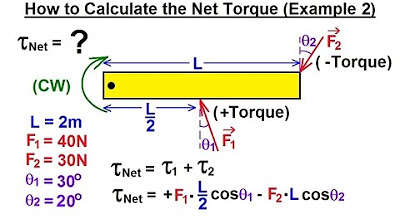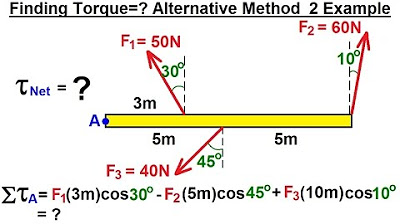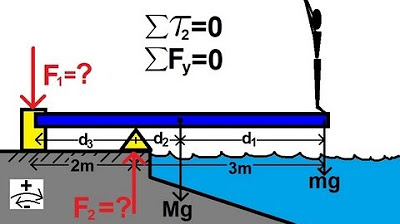Lesson 6 - Finding The Resultant Of Two Forces, Part 2 (Engineering Mechanics Statics)
TLDRIn this engineering mechanics tutorial, the focus is on statics and specifically on calculating the resultant force of two vectors, F1 and F2. F1 is 900 Newtons and F2 is 600 Newtons, with F1's arrow being longer to represent its greater magnitude. The angles provided include the 35-degree angle between F1 and the x-axis, and the 40-degree angle between F2 and F1, which is the interior angle. The goal is to find the magnitude and direction of the resultant force, which is the vector resulting from the addition of F1 and F2. The video suggests a practical scenario where F1 and F2 could represent forces pulling on an eye bolt, and emphasizes the importance of a sanity check before solving the problem. The method involves drawing a parallelogram to represent the forces and using trigonometric laws such as the law of sines and law of cosines to find the resultant force, ensuring that the solution aligns with the expected outcome based on the magnitudes and directions of the forces.
Takeaways
- 📚 The lesson is focused on statics and finding the resultant force of two vectors using various rules and laws.
- 📐 The problem involves two forces, F1 (900 Newtons) and F2 (600 Newtons), with F1 being larger as indicated by the longer arrow.
- 🧭 Given angles include the angle between F1 and the x-axis (35 degrees) and the angle between F2 and F1 (40 degrees).
- 🔍 The objective is to find the magnitude and direction of the resultant force, which is the vector sum of F1 and F2.
- 📈 A sanity check is suggested before solving, to predict the expected direction of the resultant based on the magnitudes of F1 and F2.
- 🟣 Drawing a parallelogram representing the forces can help visualize and solve for the resultant force using trigonometric laws.
- 📐 The law of sines and law of cosines will be applied to find unknown angles and sides of the parallelogram formed by the forces.
- 🔄 If F1 and F2 had the same magnitude, the resultant would be expected to be at the midpoint, bisecting the angle between them.
- ⚙️ The example provided involves an eyebolt with ropes pulling in different directions, illustrating a practical application of the concept.
- 📝 The resultant force is expected to be tilted more towards the larger force (F1), reflecting its greater magnitude in the final direction.
- 📌 The process involves careful drawing and analysis of the forces and angles to apply the appropriate mathematical rules for accurate calculation.
Q & A
What is the topic of the lesson?
-The topic of the lesson is statics, specifically focusing on finding the resultant forces of two vectors using various rules such as the parallelogram rule, triangle rule, law of sines, and law of cosines.
What are the magnitudes of the two forces, F1 and F2, in the given problem?
-The magnitude of F1 is 900 Newtons and the magnitude of F2 is 600 Newtons.
What is the angle between F1 and the x-axis?
-The angle between F1 and the x-axis is 35 degrees.
What is the angle between F2 and F1, referred to as the interior angle in the script?
-The angle between F2 and F1, which is the interior angle, is 40 degrees.
What is the resultant force?
-The resultant force is the vector sum of two or more vectors, which in this context is the combined force of F1 and F2.
What two pieces of information are generally sought when finding the resultant force?
-When finding the resultant force, one generally seeks to find its magnitude (the length of the vector) and its direction (the angle to the x-axis).
What is a sanity check in the context of problem-solving?
-A sanity check is an initial assessment or estimation to verify that the expected outcome of a problem aligns with the physical or logical implications of the problem statement.
What is the parallelogram rule in the context of vector addition?
-The parallelogram rule is a method used in vector addition where the vectors to be added are represented as adjacent sides of a parallelogram, and the resultant vector is represented by the diagonal of the parallelogram.
What is the triangle rule in vector addition?
-The triangle rule is a method of vector addition where the vectors are represented as two sides of a triangle and the resultant vector is the third side, opposite the angle between the two vectors.
What are the law of sines and law of cosines used for in the context of the lesson?
-The law of sines and law of cosines are trigonometric principles used to find unknown angles or sides in a triangle, which can be applied in vector addition to find the resultant force when angles and magnitudes of forces are known.
Why is it important to draw a parallelogram when using the parallelogram rule?
-Drawing a parallelogram helps visualize the relationship between the two forces and the resultant force. It assists in applying the parallelogram rule by providing a geometric representation of the vectors and their resultant.
What is the expected direction of the resultant force if F1 and F2 had the same magnitude?
-If F1 and F2 had the same magnitude, the resultant force would be expected to be directed at an angle that splits the difference between the directions of F1 and F2.
How does the magnitude of F1 affect the expected direction of the resultant force?
-Since F1 has a greater magnitude than F2, the expected direction of the resultant force is tilted more towards the direction of F1.
Outlines
📚 Introduction to Statics and Resultant Forces
This paragraph introduces the topic of the video, which is about statics and finding the resultant force of two vectors. The video will cover the use of parallelogram rules, triangle rules, law of sines, and law of cosines to calculate the resultant force. The problem presented involves forces F1 and F2, with F1 being 900 Newtons and F2 being 600 Newtons. The angles given are 35 degrees for F1 with respect to the x-axis and 40 degrees as the interior angle between F1 and F2. The goal is to find both the magnitude and direction of the resultant force, which is the combined effect of F1 and F2. The paragraph also suggests a preliminary visual analysis, indicating that the resultant force is expected to be tilted towards F1 due to its greater magnitude.
Mindmap
Keywords
💡Statics
💡Resultant Force
💡Parallelogram Rule
💡Triangle Rule
💡Law of Sines
💡Law of Cosines
💡Magnitude
💡Direction
💡Newton
💡Angle
💡Vector
Highlights
Lesson focuses on statics and finding resultant forces of two vectors using geometric rules.
Introduction to the parallelogram rule, triangle rule, law of sines, and law of cosines for vector addition.
Problem statement involves finding the magnitude and direction of the resultant force of F1 (900 Newtons) and F2 (600 Newtons).
Angles provided: angle between F1 and the x-axis is 35 degrees, and the interior angle between F1 and F2 is 40 degrees.
The resultant force is the vector sum of F1 and F2, which can be visualized as a force acting on an eye bolt.
If F1 and F2 had the same magnitude, the resultant would split the difference between them.
Since F1 has a greater magnitude, the resultant is expected to be tilted more towards F1.
The importance of performing a sanity check on the expected direction of the resultant before solving the problem.
Drawing a parallelogram with the given forces to utilize geometric rules for finding the resultant.
The use of freehand drawing to approximate the vectors and angles for the parallelogram representation.
Identification of F2 as the 600 Newton force and its representation in the parallelogram diagram.
Representation of F1 as the 900 Newton force and its placement in the parallelogram diagram.
The resultant force is found by applying geometric rules to the parallelogram formed by F1 and F2.
The lesson emphasizes the practical application of statics in real-world scenarios, such as forces acting on a bolt.
Understanding the relationship between the magnitudes of F1 and F2 and their impact on the direction of the resultant force.
The process of finding the resultant involves both mathematical calculation and graphical representation for clarity.
The lesson concludes with a clear demonstration of how to apply the parallelogram rule to find the resultant force of two vectors.
Transcripts
Browse More Related Video

Calculating the Resultant force Using Parallelogram Law, ለኢትዮጵያውያን

Lesson 5 - Finding The Resultant Of Two Forces, Part 1 (Engineering Mechanics Statics)

How To Use The Parallelogram Method To Find The Resultant Vector

Physics 15 Torque Fundamentals (11 of 13) How to Calculate the Net Torque? Ex. 2

Physics 15 Torque (9 of 27) Alternative Method 1 & 2: Example Torque=?

Physics 15 Torque Example 4 (4 of 7) The Diving Board
5.0 / 5 (0 votes)
Thanks for rating: